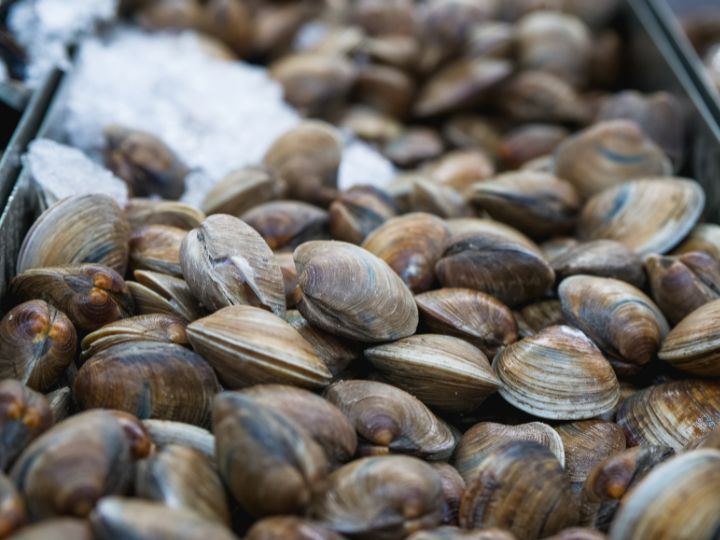Clams, being a critical food source for various marine and terrestrial creatures, play an essential role in the ecosystem. As bivalve mollusks, clams thrive in both freshwater and saltwater habitats, providing nourishment to a wide variety of animals. This article aims to explore the diverse array of animals that include clams in their diet and the many ways they are consumed.
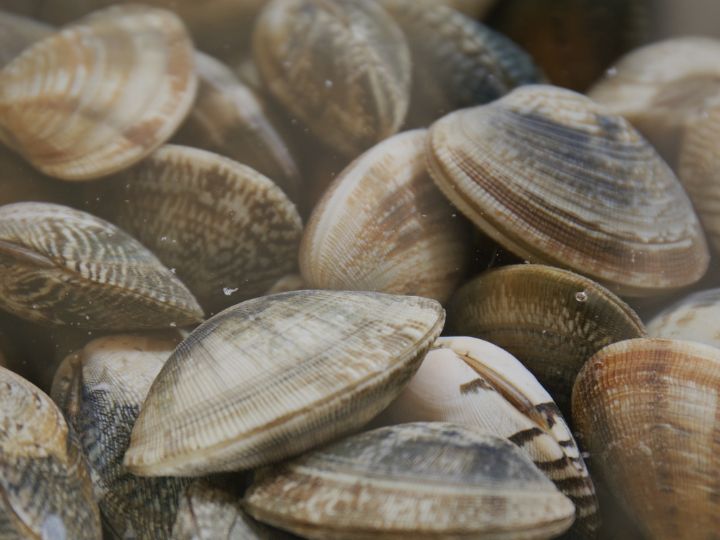
Image Credit: Canva
Predators of clams have adapted unique skills to crack open the shells that protect the nutritious meat inside. From impressive strength and precision to clever utilization of tools and cooperation, these animals display an array of strategies to access this valuable food source. Delving into these fascinating techniques provides insight into the natural world and the intricate balance that resides within it.
It is essential to understand the relationships between clams and their predators, as it can lead to a broader comprehension of the myriad interconnected food chains present within oceanic and freshwater environments. Identifying the key predators of clams not only enhances our understanding of aquatic life but also highlights the importance of preservation and sustainability efforts to maintain these ecosystems for creatures relying on clams for survival.
Marine Mammals Eating Clams
Sea Otters
Sea otters are well-known for their ability to consume a variety of marine invertebrates, including clams. They primarily use their strong teeth and powerful jaw muscles to crush the hard shells of clams, enabling them to access the nutritious meat inside. Sea otters often use tools, such as rocks, to crack open the shells, displaying their remarkable problem-solving skills.
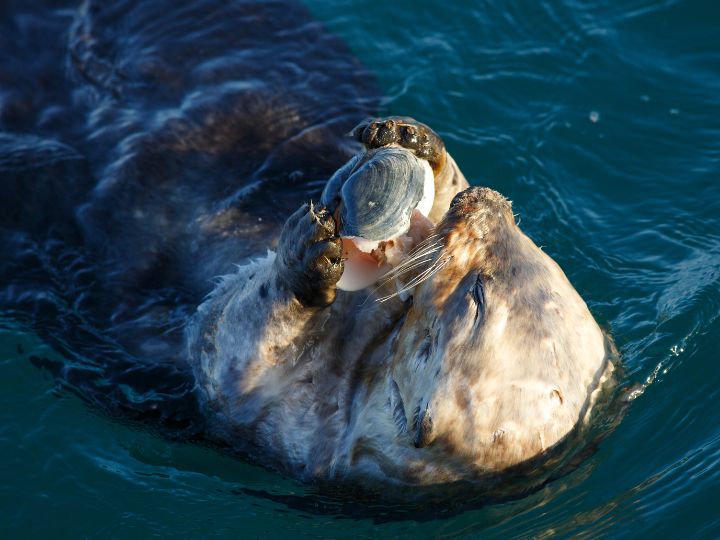
Image Credit: Canva
When sea otters encounter a group of clams, they usually dive to the ocean floor and gather as many as possible. They then return to the surface and expertly use their agile paws to handle their catch. Moreover, they often store their food in a pouch located in their armpit while they feast on other pieces of their catch.
Harbor Seals
Harbor seals also have clams as part of their diet. While they may not exhibit the same tool-using skills as sea otters, harbor seals are still effective predators of clams. They rely on their excellent sense of touch to help them locate clams buried in the sediment on the seafloor.
Once they have located a clam, harbor seals use their powerful jaws to bite into the shell and extract the delicious contents. When hunting for clams, harbor seals display a great deal of patience and persistence, as they must sift through the sand and mud to find their prey.
To better illustrate the diet composition of sea otters and harbor seals, here’s a brief table:
| Marine Mammal | Diet Composition |
|---|---|
| Sea Otters | Clams, sea urchins, crabs, snails, fish, squid, and other invertebrates |
| Harbor Seals | Clams, fish, crustaceans, and other marine invertebrates |
Both sea otters and harbor seals contribute to keeping the populations of various marine organisms, such as clams, in balance. This helps maintain the overall health and biodiversity of their respective ecosystems.
Birds Eating Clams
Seagulls
Seagulls are well-known for their dietary versatility, and clams are no exception. Along coastal areas, these birds can be observed using their strong beaks to break open the clams’ shells. Seagulls will often drop clams from a height onto rocks or other hard surfaces, utilizing gravity to crack the shells and access the meat inside. Clams are a vital food source for seagulls and contribute to their overall survival in these environments.
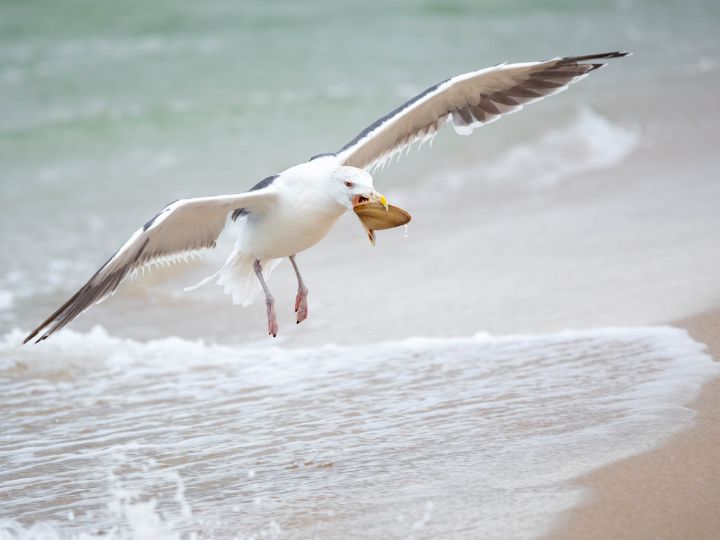
Image Credit: Canva
Ospreys
Ospreys are primarily known for their fish-eating habits, but they occasionally consume clams as well. These raptors have a strong affinity for marine habitats, and will not hesitate to expand their diet when fish are scarce. Ospreys tend to utilize their powerful talons to break the clams’ shells, either by picking them up and dropping them from the air or by crushing them against hard surfaces. Clams make up a small but significant portion of ospreys’ diets, especially during periods of limited fish availability.
Crows
Crows are considered one of the most intelligent bird species and have a diverse diet that includes clams. They have been observed using tools, such as sticks or their own beaks, to pry open the shells of clams. Additionally, similar to seagulls and ospreys, crows have been known to drop the clams from a height in order to crack them open. Clams provide a nutritious food source for crows, contributing to their overall well-being and adaptability in various environments.
Other Animals
Raccoons
Raccoons are known for their diverse diet and adaptability. They have been observed feeding on clams in their natural habitat. Using their dexterous front paws, raccoons pry open the clamshells to consume the soft meat inside. They are skilled hunters in both aquatic and terrestrial environments, which enables them to successfully prey upon clams.
Humans
Humans have been consuming clams for centuries, and they remain a popular seafood choice in many cultures around the world. Clams provide a valuable source of protein and essential nutrients for humans. They can be prepared in various ways, including steaming, boiling, and frying. Clams are often used in dishes such as pasta, chowders, and stews. In some regions, raw clams are enjoyed as a delicacy, typically served with a side of sauce or garnish.
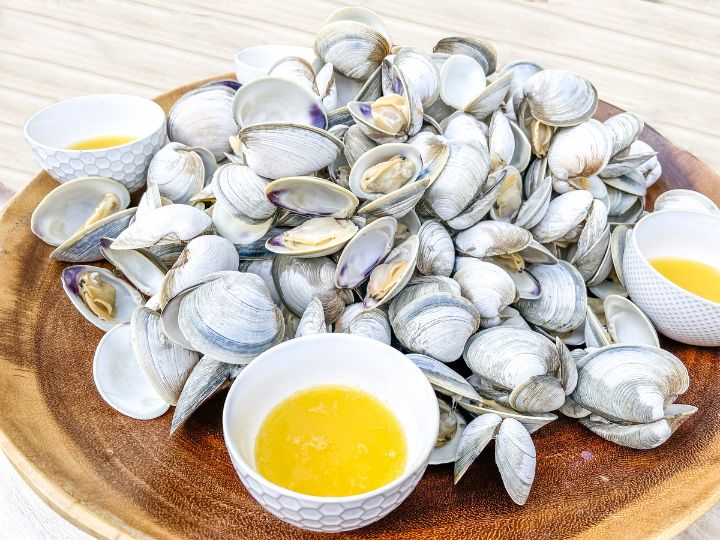
Image Credit: Canva
Survival Mechanisms of Clams
Clams have developed a variety of survival mechanisms over time, aiding in their ability to thrive in a range of habitats. These bivalve mollusks have strong and sturdy shells which provide protection against predation and environmental challenges.
One notable survival mechanism is their ability to burrow into the sediment. Clams use their muscular foot to dig into the substrate, which not only provides safety from predators but also enables them to access food resources. By siphoning water through their gills, clams filter out and consume small particles, such as phytoplankton and detritus.
Furthermore, clams possess an efficient and adaptive respiratory system. They can survive under low-oxygen conditions by increasing the rate at which they pump water through their gills, thereby maximizing the extraction of dissolved oxygen. This ability to regulate their respiration rate allows clams to survive in diverse aquatic environments.
Lastly, clams can reproduce both sexually and asexually, allowing them to effectively increase their population size and adapt to their surroundings. Some species are hermaphroditic, carrying both male and female reproductive organs, thus increasing their chances of successful reproduction.
Overall, the combination of protective shells, burrowing and siphoning capabilities, an adaptive respiratory system, and versatile reproduction methods make clams resilient and successful animals within their habitats.
Impact on Clam Population
The consumption of clams by various animals significantly affects the clam population. Predators such as sea otters, crabs, moon snails, and birds like seagulls and ducks all partake in feasting on these shellfish, leading to a natural balance in marine ecosystems.
Sea otters, for example, are known to be voracious clam eaters. They are highly skilled at locating and prying open their hard shells, consuming large numbers of clams in the process. Their hunting technique includes using rocks as tools to break clam shells, which has a considerable impact on the overall population.
Likewise, crabs also pose a threat to clams, particularly during their vulnerable juvenile stage. Species like the green crab can consume dozens of juvenile clams in a single day. This predation can significantly decrease clam populations if left unchecked.
Additionally, moon snails are well known for drilling holes through clam shells to consume the soft tissue inside. Their specialized feeding habits make them a significant predator in the clam population dynamic.
Moreover, several bird species, including seagulls and ducks, rely on clams as a food source. In particular, diving ducks such as mergansers, scaups, and scoters exert strong predation pressure on the clam population.
While each of these predators contributes to the overall decrease in clam populations, it is essential to consider that a healthy ecosystem relies on the balance of predator-prey dynamics. As the number of clams dwindles due to predation, the decrease in available food will, in turn, affect the population of these predators, eventually leading to a stabilization of the clam population.
Conclusion
Clams, as a food source for various animals, play a significant role in marine ecosystems. Predators of clams include marine mammals, birds, fish, and invertebrates.
Marine mammals such as sea otters and harbor seals are known to consume clams. They use their specialized teeth and strong jaws to crack open the clam shells. In addition, birds like seagulls, oystercatchers, and herons are observed feeding on clams by either diving to catch them or using their long beaks to extract the clam’s soft body.
Fish species, including flounder, red drum, and striped bass, also prey on clams. Some fish use their specialized mouths to suction clams from the sediment, while others crush their shells with strong pharyngeal teeth.
In the realm of invertebrates, certain species of crabs, octopuses, and sea stars are among the main predators of clams. These predators employ various strategies, such as the use of claws or drilling into the shells, to access the clam’s soft tissues.
In summary, clams are essential to the diets of a diverse array of marine animals. Their presence and predation in the ecosystem contribute to the complex balance within marine habitats. The interconnectivity between clams and their predators is crucial for the health and sustainability of these ecosystems.
Frequently Asked Questions
How do clams fit into the food chain?
Clams play a crucial role in the food chain as they serve as a food source for various marine creatures, including fish, crustaceans, and mammals. Additionally, as filter feeders, clams help maintain water quality by filtering out pollutants and excess nutrients, which in turn supports healthier marine ecosystems.maintain
Becky is a fervent wildlife enthusiast and pet care expert with a diploma in canine nutrition. Her love for animals stretches beyond the domestic, embracing the wild tapestry of global fauna. With over a decade of experience in animal welfare, Becky lends her expertise to OutlandishOwl through insightful articles, captivating wildlife information, and invaluable guidance on pet nutrition. Her work embodies a deep commitment to understanding the intricate lives of animals and a passion for educating others on sustaining natural habitats. Becky's hands-on conservation efforts and her knack for translating complex dietary science into practical pet feeding tips make her an indispensable voice for creatures great and small.

